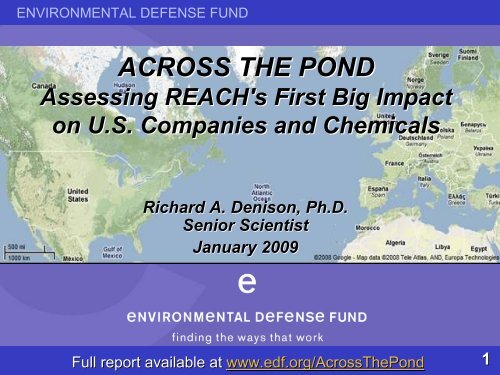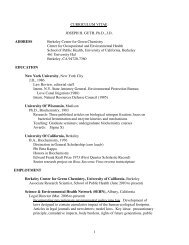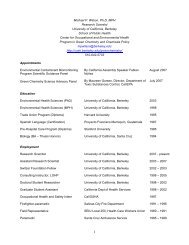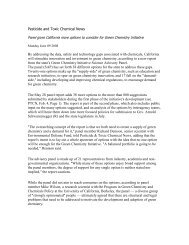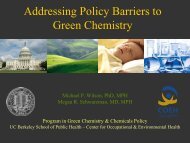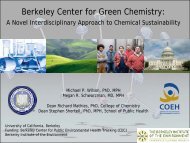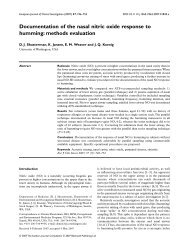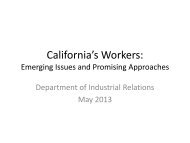ACROSS THE POND Assessing REACH's First Big Impact on U.S. ...
ACROSS THE POND Assessing REACH's First Big Impact on U.S. ...
ACROSS THE POND Assessing REACH's First Big Impact on U.S. ...
- No tags were found...
You also want an ePaper? Increase the reach of your titles
YUMPU automatically turns print PDFs into web optimized ePapers that Google loves.
ENVIRONMENTAL DEFENSE FUND<str<strong>on</strong>g>ACROSS</str<strong>on</strong>g> <str<strong>on</strong>g>THE</str<strong>on</strong>g> <str<strong>on</strong>g>POND</str<strong>on</strong>g><str<strong>on</strong>g>Assessing</str<strong>on</strong>g> <str<strong>on</strong>g>REACH's</str<strong>on</strong>g> <str<strong>on</strong>g>First</str<strong>on</strong>g> <str<strong>on</strong>g>Big</str<strong>on</strong>g> <str<strong>on</strong>g>Impact</str<strong>on</strong>g><strong>on</strong> U.S. Companies and ChemicalsRichard A. Denis<strong>on</strong>, Ph.D.Senior ScientistJanuary 2009Full report available at www.edf.org/AcrossTheP<strong>on</strong>d1
ENVIRONMENTAL DEFENSE FUNDWhat does the SIN Listhave to do with the U.S.?• REACH applies equally to imports• U.S. companies making/importingSVHCs will get increasing scrutiny• List-driven approaches underc<strong>on</strong>siderati<strong>on</strong> in ME, WA, OR, CAand for federal TSCA reform2
ENVIRONMENTAL DEFENSE FUNDQuesti<strong>on</strong>s to be explored• Which SIN List chemicals are in UScommerce?• In what amounts?• Made or imported by whichcompanies?• In which states and at which sites?3
ENVIRONMENTAL DEFENSE FUNDQuesti<strong>on</strong>s to be explored• Which SIN List chemicals havebeen tested in the U.S.?• Which have been regulated byEPA?• How many have been exemptedfrom regulatory requirements?4
ENVIRONMENTAL DEFENSE FUNDWhere to get US producti<strong>on</strong> data?• TSCA Inventory Update Rule (IUR)* requiresperiodic manufacturer/importer reporting• 1986-19901990-1994-1998-2002– Site locati<strong>on</strong>, volume range <strong>on</strong>ly– ≥10,000 lbs/yr/site threshold• 2006-20112011-2016, 2016, etc.– Downstream processing/use/exposure data– ≥25,000 lbs/yr/site threshold* Available at www.epa.gov/iur5
ENVIRONMENTAL DEFENSE FUNDSummary of 2006 IUR data• Reflects producti<strong>on</strong> or import in 2005 <strong>on</strong>ly• Public databases include:– ~6,200 chemicals– ~1,540 companies at ~3,825 sites– ~24,400 site records (unique co/site/chemchem)• But chemicals/companies/sites can be CBI– >1,300 CBI chemicals not in 2002 public database• IUR total 2005 volume is 27 trilli<strong>on</strong> pounds– >95% is domestically produced6
ENVIRONMENTAL DEFENSE FUNDFrom USEPA, N<strong>on</strong>-c<strong>on</strong>fidential 2006 IUR Records by Chemical, www.epa.gov/iur7
ENVIRONMENTAL DEFENSE FUNDFrom USEPA, N<strong>on</strong>-c<strong>on</strong>fidential 2006 IUR Records by Company, www.epa.gov/iur8
ENVIRONMENTAL DEFENSE FUNDLimitati<strong>on</strong>s to IUR Data• Many exempti<strong>on</strong>s, e.g.:– Producti<strong>on</strong> for n<strong>on</strong>-TSCA regulated uses– Polymers– R&D chemicals– Chemicals imported as part of an article– N<strong>on</strong>-isolated intermediates– Small manufacturers• Dated and <strong>on</strong>ly 1 yr (2005), despite large fluctuati<strong>on</strong>s• High threshold of 25,000 pounds per site• Public can’t t see CBI chemicals/companies/sites9
ENVIRONMENTAL DEFENSE FUNDWhich SIN List chemicals are in US commerce?• ≥ 80% are <strong>on</strong> the TSCA Inventory– ~ 83,000 chemicals: made at some point since1979– Identities of ~15,000 are CBI, could include some<strong>on</strong> SIN List• 38% reported <strong>on</strong> 2006 IUR, excluding:–
ENVIRONMENTAL DEFENSE FUND11In what amounts are SIN List chemicalsproduced or imported in the US?• EPA reports aggregate volumes <strong>on</strong>ly in broad ranges25Volume distributi<strong>on</strong> for 107 IUR reported SIN List chemicals(176 not reported)Number of chemicals20151050>1B 500M -
ENVIRONMENTAL DEFENSE FUNDIn what amounts are SIN List chemicalsproduced or imported in the US?IUR volume distributi<strong>on</strong> for SIN List Chemicals, lbs in 2005LPV *1 milli<strong>on</strong>34%* chemicals not reported; somemay no l<strong>on</strong>ger be in commerceMPV25,000—1 milli<strong>on</strong>13%12
ENVIRONMENTAL DEFENSE FUND13In what amounts are SIN List chemicalsproduced or imported in the US?• 14 SIN List chemicals >1 1 billi<strong>on</strong> poundsBisphenol AAcryl<strong>on</strong>itrileStyrene 2,4-DinitrotolueneEthanol, 2-ethoxy2ethoxy-, , 1-acetate1FormaldehydeAniline1,3-ButadieneEthylene dichlorideCarb<strong>on</strong> m<strong>on</strong>oxideBenzeneVinyl chlorideEthylene oxidePropylene oxide
ENVIRONMENTAL DEFENSE FUNDWhich companies produce/importSIN List chemicals in the US?• 235 companies reported producti<strong>on</strong> or import of atleast 1 SIN List chemical.– 114 producers, 135 importers, 38 claimed CBICompany # Manufactured # Imported # CBI Total*BASF Corporati<strong>on</strong> 3 13 0 16The Dow Chemical Company 11 11 0 14E. I. du P<strong>on</strong>t de Nemours and Co. 9 5 0 12Huntsman Corporati<strong>on</strong> 4 6 0 9Chemtura Corporati<strong>on</strong>(formerly Great Lakes Chem.)0 0 9 9ICC Chemical Corporati<strong>on</strong> 0 8 0 8Ferro Corporati<strong>on</strong> 5 2 0 7Albemarle Corporati<strong>on</strong> 4 4 1 7* Numbers do not add to total because a chemical may be produced and imported by the same company.14
ENVIRONMENTAL DEFENSE FUNDWhich companies produce/importSIN List chemicals in the US?• Many SIN List chemicals produced by multiplecompanies and at many different sites.Chemical name # Companies # SitesBenzene 41 62Styrene 19 251,3-Butadiene 17 22Formaldehyde 16 42Ethylene dichloride 15 22Nickel m<strong>on</strong>oxide 14 24Hexane 13 15Bisphenol A 10 13Vinyl chl or ide 9 13Ethylene oxide 9 13N<strong>on</strong>ylphenol ethoxylate 7 23Car b<strong>on</strong> m<strong>on</strong>oxide 4 1415
ENVIRONMENTAL DEFENSE FUNDIn which states are SIN List chemicalsproduced or imported?• 42 states as well as Puerto Rico and the Virgin Islands.# of Chemicals # of SitesProduced Imported CBI Total* Produced Imported CBI Total*Texas 29 31 10 48 65 35 8 100New Jersey 8 26 3 35 6 12 3 21Ohio 11 19 2 30 12 15 2 27Louisiana 21 7 4 27 31 6 4 38New York 2 22 3 25 2 12 2 15North Carolina 8 9 6 22 10 5 2 16Pennsylvania 12 13 2 20 10 11 2 21Michigan 5 12 1 15 3 2 1 6* Numbers do not add to total because a chemical may be produced and imported in the same state or site.• California: 3 chemicals at 4 sites produced/imported.16
ENVIRONMENTAL DEFENSE FUND17In which states are SIN List chemicalsproduced or imported?• Some SIN List chemicals are produced or imported inmany different states.# of statesChemical name Produced Imported CBI Total*Formaldehyde 19 8 2 22N<strong>on</strong>ylphenol ethoxylate (NPE) 1 16 1 17Benzene 13 8 3 16Styrene 3 12 1 13Di-(2-ethylhexyl) phthalate (DEHP) 3 6 1 10* Numbers do not add to total because a chemical may be produced and imported in the same state.
ENVIRONMENTAL DEFENSE FUND18Which SIN List chemicalshave been tested in the US?• Most SIN List chemicals sufficiently testedand assessed in EU to indicate high hazard.– 234 are officially CMRs, PBTs or vPvBs– 13 are officially endocrine disruptors• What testing has been d<strong>on</strong>e under TSCA?– Mandatory testing required for 38 SIN Listchemicals (extent varies greatly)– Voluntary testing d<strong>on</strong>e or underway for 70– 28 overlap, so total of 80 (35%) have been tested
ENVIRONMENTAL DEFENSE FUNDWhich SIN List chemicalshave been regulated in the US?• TSCA restricts <strong>on</strong>ly 2 SIN List chemicals or classes:– Asbestos and Hexavalent chromium compounds• Even these regulati<strong>on</strong>s are quite limited:– Only asbestos in products no l<strong>on</strong>ger in commerceis regulated under TSCA; EPA’s s ban <strong>on</strong> all uses ofasbestos was vacated by the 5th Circuit in 1991.– Only those hexavalent chromium-based watertreatment chemicals intended for use in comfortcooling towers are banned under TSCA. Otheruses of these compounds and any otherhexavalent chromium compounds are unaffected.19
ENVIRONMENTAL DEFENSE FUND20Which SIN List chemicalshave been regulated in the US?• 20 SIN List chemicals are subject toSignificant New Use Rules (SNURs(SNURs).• SNURs do not restrict producti<strong>on</strong> oruse.• Only require notificati<strong>on</strong> if producti<strong>on</strong> oruse deviates from SNUR c<strong>on</strong>diti<strong>on</strong>s.• EPA can then review and accept, rejector impose c<strong>on</strong>diti<strong>on</strong>s.
ENVIRONMENTAL DEFENSE FUNDWhich SIN List chemicalshave been exempted in the US?• EPA has exempted 8 SIN List chemicals fromreporting under the IUR.• All are n<strong>on</strong>yl- or octylphenol ethoxylates (NPEs,OPEs), exempted because they are polymerspresumed not to be bioavailable.• Yet NPEs and OPEs:– are acutely toxic to aquatic organisms, and– break down to n<strong>on</strong>ylphenol and octylphenol,more persistent and toxic than their parentsand show endocrine-disrupting disrupting activity.21
ENVIRONMENTAL DEFENSE FUNDC<strong>on</strong>clusi<strong>on</strong>s• There is substantial US producti<strong>on</strong> and use of over100, and likely many more, SVHCs.• SVHCs are produced/imported by many differentcompanies at many sites and states.• Only ~1/3 of SIN List chemicals <strong>on</strong> TSCA Inventoryhave been subjected to any testing under TSCA.• Only very limited uses of asbestos and certain Cr-VI compounds have been subjected to regulati<strong>on</strong>.• <str<strong>on</strong>g>REACH's</str<strong>on</strong>g> focus <strong>on</strong> SVHCs will have a major impact<strong>on</strong> US companies and chemical producti<strong>on</strong> anduse.22
ENVIRONMENTAL DEFENSE FUNDPart II:IUR and the Public’s s Right to Know23
ENVIRONMENTAL DEFENSE FUNDIUR data: How much does EPAknow and what isn’t t it telling us?• All data required under IUR is eligiblefor CBI status.• EPA reports certain data <strong>on</strong>ly in rangesor aggregates across all submitters.• Some data need not be submitted if not“reas<strong>on</strong>ably ascertainable” or “readilyobtainable” by producer.• No reporting obligati<strong>on</strong> <strong>on</strong> downstreamusers.24
ENVIRONMENTAL DEFENSE FUNDIUR use and exposure dataFor reportable organic chemicals (~5,550)(“reas<strong>on</strong>ably ascertainable” data <strong>on</strong>:• # workers reas<strong>on</strong>ably likely to beexposed at site of producti<strong>on</strong>/import;• physical form(s) of the chemical and % ofproducti<strong>on</strong> volume in each form; and• maximum c<strong>on</strong>centrati<strong>on</strong> of the chemicalsubstance as it leaves the submitter'spossessi<strong>on</strong>.25
ENVIRONMENTAL DEFENSE FUNDIUR use and exposure dataFor organic HPV* chemicals <strong>on</strong>ly (~2,800)(–“readily obtainable” data <strong>on</strong>:• industrial functi<strong>on</strong>s (e.g., adhesive, solvent) and% of producti<strong>on</strong> volume for each• #, types of downstream processing andcommercial-use sites• # of workers handling chemical at each site• product categories/types (e.g., paints)• % of producti<strong>on</strong> volume and maximumc<strong>on</strong>centrati<strong>on</strong> in each product category• whether in products intended for use by children* chemicals ≥300,000 pounds per site26
ENVIRONMENTAL DEFENSE FUNDExtent of CBI claimsFrom USEPA, 2006 Inventory Update Reporting Data Summary, www.epa.gov/iur27
ENVIRONMENTAL DEFENSE FUNDExtent of NRO* claimsIUR reporting category # chemicals NRO % NROIndustrial processing and use informati<strong>on</strong> 337 11%Industrial functi<strong>on</strong> category 419 14%Commercial or c<strong>on</strong>sumer product category 427 20%Use in product intended for use by children 814 38%* NRO = not readily obtainable28
ENVIRONMENTAL DEFENSE FUNDWhat else can’t t the public see?EPA’s s reporting methods obscure data that aren’teven claimed CBI.• Uses <strong>on</strong>ly broad aggregate ranges instead ofchemical-specific data or ranges for:– Producti<strong>on</strong> volume (yet <strong>on</strong>ly 20-30% is CBI)– # of processing sites, workers (28% CBI)• Use of <strong>on</strong>ly Yes/No indicators and chemicalcounts instead of chemical-specific data for:– Industrial processing/use (26-49% CBI)– Commercial/c<strong>on</strong>sumer use (26% CBI)• No data <strong>on</strong> % of producti<strong>on</strong> volume provided29
ENVIRONMENTAL DEFENSE FUNDOver-broadrangesandYes/Noindicatorsinstead ofchemicaland site-specificdataFrom USEPA, N<strong>on</strong>-c<strong>on</strong>fidential 2006 IUR Records by Chemical, www.epa.gov/iur30
ENVIRONMENTAL DEFENSE FUNDEPA’s s reporting uses overbroad rangesProducti<strong>on</strong> VolumeBenzene1,2-dichloroethaneRange in IURdatabaseRange in IURreport*≥1B15-20B≥1B25-30BData required tobe reportedActual volume to2 sign. figures* These narrower ranges are provided <strong>on</strong>ly for top 100 chemicalsRangesused inEPA’spublicIURdatabase
ENVIRONMENTAL DEFENSE FUND32EPA’s s reporting uses overbroad rangesRequiredreportingranges for #workersEPA’spublicdatabaserangesRequiredreportingranges for #sites
ENVIRONMENTAL DEFENSE FUNDFrom USEPA, 2006 Inventory Update Reporting Data Summary, www.epa.gov/iur33
ENVIRONMENTAL DEFENSE FUND34What data should EPA provide?• Provide all chemical- and site-specific data that are not CBI– after reviewing and allowing <strong>on</strong>lylegitimate CBI claims.• Indicate, for each chemical andsite, those reporting elements thatare claimed CBI or NRO.


